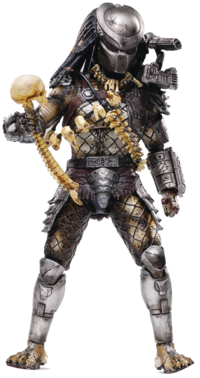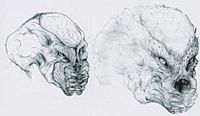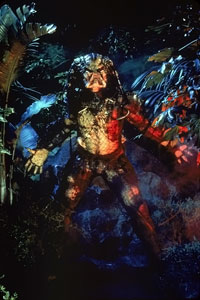Predator (fictional species) facts for kids
Quick facts for kids Predator |
|
|---|---|
| Predator race | |

A Predator, based on the one from the first film.
|
|
| Also known as | Yautja |
| First appearance | Predator (1987) |
| Created by |
|
| Information | |
| Home world | Yautja Prime |
| Type | Tribal extraterrestrial |
The Predator, also known as Yautja, is a famous alien species from the Predator science fiction movies. These creatures are known for hunting other strong species for sport, collecting their trophies. They first appeared in the 1987 movie Predator. Since then, they have been in many other films like Predator 2 (1990), Predators (2010), The Predator (2018), and the prequel Prey (2022). They also appeared in crossover movies with the Alien creatures, such as Alien vs. Predator (2004) and Aliens vs. Predator: Requiem (2007).
The Predator species has also been featured in many books, video games, and comic books. Sometimes they are called "Hunters" in the movies. In the wider story universe, they are known as Yautja or Hish-qu-Ten. The creatures were created by brothers Jim and John Thomas. Predators are shown as tall, intelligent, and feeling human-like beings. They have amazing technology, including active camouflage (which makes them invisible), powerful energy weapons, and spaceships that can travel between stars.
Creating the Predator: Design and Actors
How the Predator Was Designed

The unique look of the Predator was created by a special effects artist named Stan Winston.
The first ideas for the Predator's design were very different. It had a long neck, a head like a dog, and only one eye. However, this design was too difficult to film in the jungle. So, Stan Winston was asked to create a new, more practical design. It took eight months to finish the new Predator suit.
Actors Who Played the Predator

Originally, martial arts star Jean-Claude Van Damme was cast as the Predator. The idea was for the Predator to be a quick, ninja-like hunter. However, the first costume was very clumsy and hard to move in, especially in the muddy jungle.
Also, Van Damme was much smaller than the other actors in the movie, like Arnold Schwarzenegger. The filmmakers realized they needed a much bigger actor to make the creature look truly scary. So, Van Damme was replaced by Kevin Peter Hall. Hall was a tall actor and a mime artist. He used his mime skills to give the Predator its unique movements in the first two movies. Sadly, Hall passed away not long after Predator 2 was released.
The clicking and growling sounds of the Predator were made by Peter Cullen. He made these sounds carefully so he wouldn't hurt his voice.
In later movies, other actors took on the role:
- In Alien vs. Predator, Ian Whyte played the "Scar" Predator. He also played the "Wolf" Predator in Aliens vs. Predator: Requiem.
- In Predators, Brian Steele and Carey Jones played the "Black Super Predators." Derek Mears played the "Classic Predator," which looked like the original.
- In The Predator, stuntman Brian A. Prince played the main Predator. A much larger, genetically-enhanced Predator was mostly created using computer graphics (CGI).
- In the prequel Prey, Dane DiLiegro played a more ancient Predator. This Predator used more brute strength and hand-to-hand fighting, and its technology was simpler than the later Predators.
Special Effects for the Predator
The Predator's glowing green blood was made by mixing liquid from glow sticks with a special jelly. This mixture quickly lost its glow, so new batches had to be made very often during filming. This cool effect was used in all the movies featuring the Predator.
The Predator's famous camouflage effect, which makes it seem invisible, was designed by R/Greenberg Associates. The idea came from a dream one of the writers had about a reflective, blending man. The effect was created by repeating an image in wavy patterns around the Predator's body. This made it look like the air around the Predator was bending light, making it hard to see. Before digital effects, this was all done using special film techniques.
Predator Characteristics and Culture
What Predators Look Like
Predators are taller than humans. They have mouthparts like insects, called mandibles, and long, hair-like parts on their heads that look like dreadlocks. Their bodies are very tough and can heal from many injuries, even gunshot wounds and radiation that would kill a human. They carry a special kit to help them heal.
Predators are much stronger than humans. They can easily overpower an adult human and even break solid concrete with their bare hands. They are also excellent climbers, moving quickly through trees or across rooftops when hunting. While they can survive in very cold places, they seem to prefer hot, tropical climates. Their blood glows green.
Their vision works mainly by seeing heat, like an infrared camera. This means they can easily spot warm bodies but struggle to see objects that are all the same temperature. Their special masks help them see in many different ways, from low heat to high ultraviolet light. This mask also helps them filter out background heat, allowing them to see things more clearly. They can breathe Earth's air, but sometimes they use a breathing mask, perhaps to filter out pollution.
Over the years, the Predator's design has changed a bit in different movies. For example, in Predator 2, the main Predator looked more "urban" with brighter skin and more fangs. In Alien vs. Predator, they were made to look more heroic. In Predators, the "Black Super Predators" were designed to be taller and leaner with longer faces.
Predator Culture and History
Predator society builds advanced spaceships, but they shouldn't look as sleek as a Star Wars stormtrooper. They are a tribal culture, but they shouldn't look as primitive as the orcs from Lord of the Rings. They are also a warrior culture, so their fancy designs must still be practical.
The Predator culture is all about hunting dangerous creatures. They don't hunt for food or to get rid of threats. Instead, they hunt for sport or as a special test, like a rite of passage. They only attack life forms that can give them a real challenge. In Predators, we learn there are at least two different Predator tribes that have been fighting each other for a long time.
Predators visited ancient human civilizations, like the Ancient Egyptians, Aztecs, and the Comanche Nation. When they came to Earth, humans sometimes worshipped them as gods. The Predators even taught some civilizations how to build pyramids. In return, the Predators expected humans to offer sacrifices. These sacrifices were used as hosts for Xenomorphs (Aliens), which were the ultimate prey for young Predators learning to hunt.
The Predators would return every century to continue this agreement. However, at one point, the Xenomorphs got out of control. The Predators had to detonate a bomb that destroyed the entire civilization. After this, the relationship between humans and Predators changed. Predators began to see humans as just another type of prey to hunt.
Predators are part of the stories and legends of some cultures. Some people in Latin America call them "El Diablo que hace trofeos de los hombres" (Spanish for "The Demon who makes trophies of men"). In Jamaica, some superstitions say Predators are demons from the spirit world.
Predator Language
The written language of the Predators looks like patterns of dashes. You can see these symbols on their wrist devices, helmets, and buildings. The sounds Predators make are mostly clicks, roars, snarls, and growls. These sounds are actually made from recordings of many different animals, like lions, tigers, dolphins, and elephants.
Sometimes, Predators will copy human language. They can use their helmets to understand and speak human languages. Some Predators have even learned to speak human languages without their helmets.
Predator Movies
- Predator (1987)
- Predator 2 (1990)
- Alien vs. Predator (2004)
- Aliens vs. Predator: Requiem (2007)
- Predators (2010)
- The Predator (2018)
- Prey (2022)
See also
 In Spanish: Depredador (alienígena) para niños
In Spanish: Depredador (alienígena) para niños

